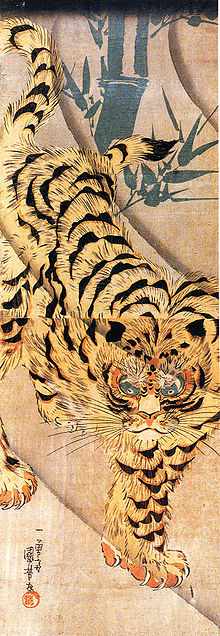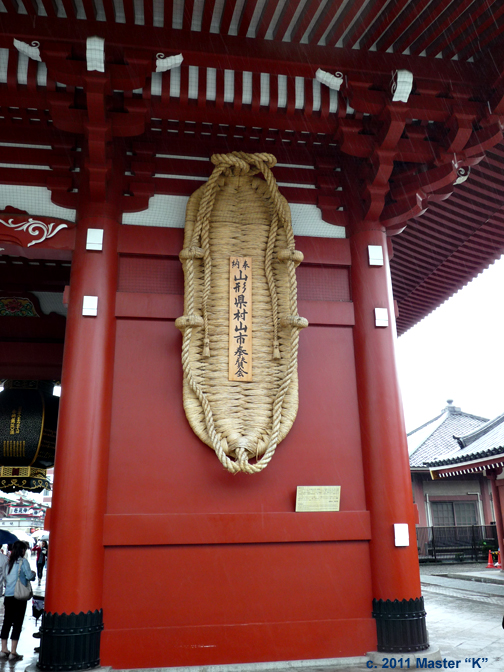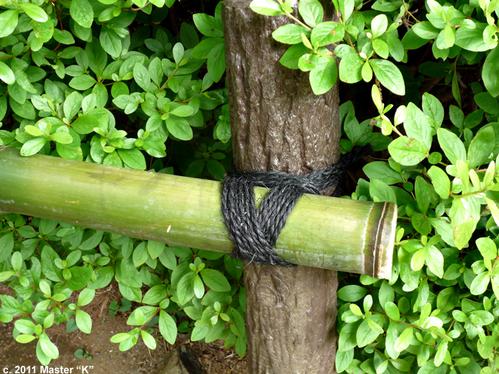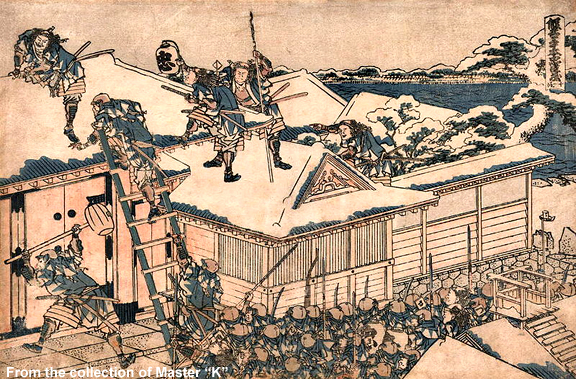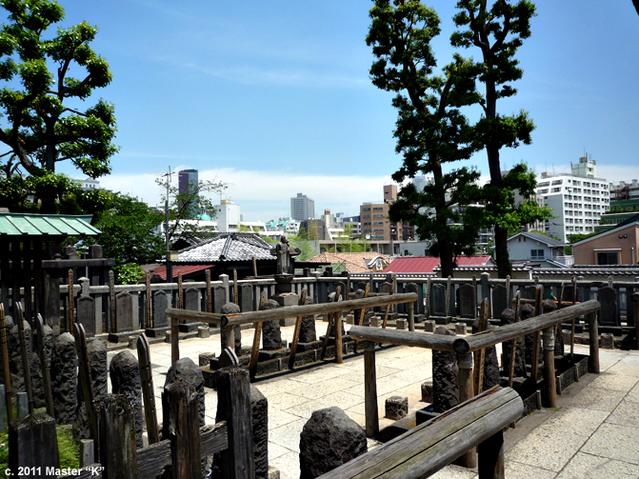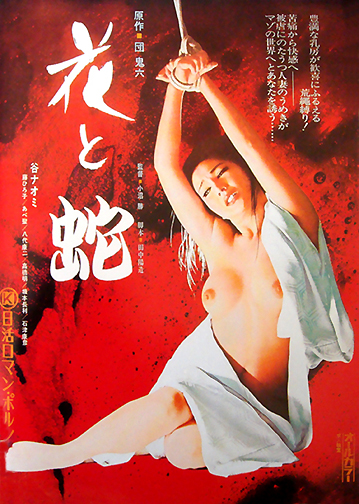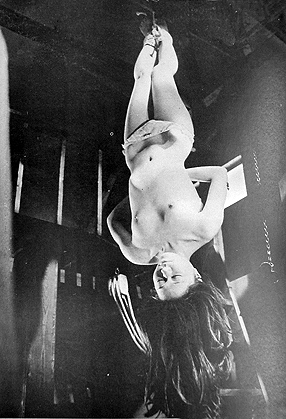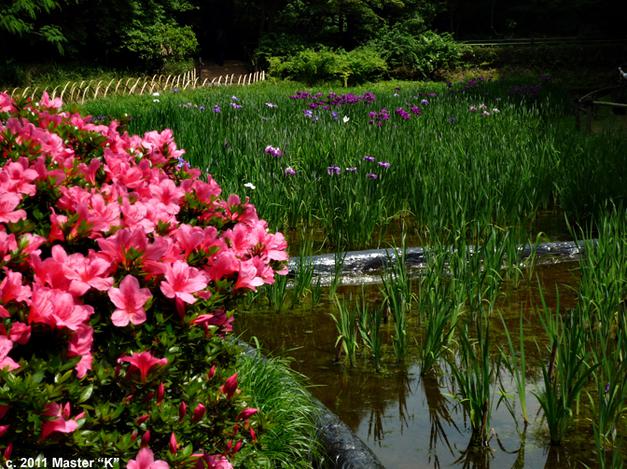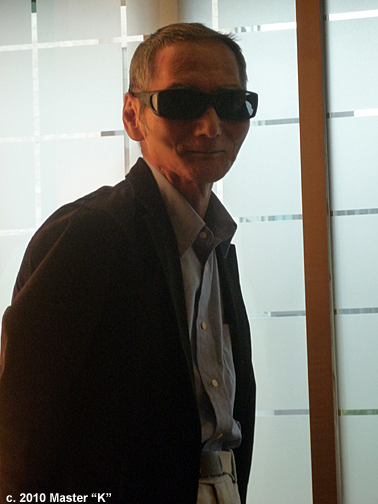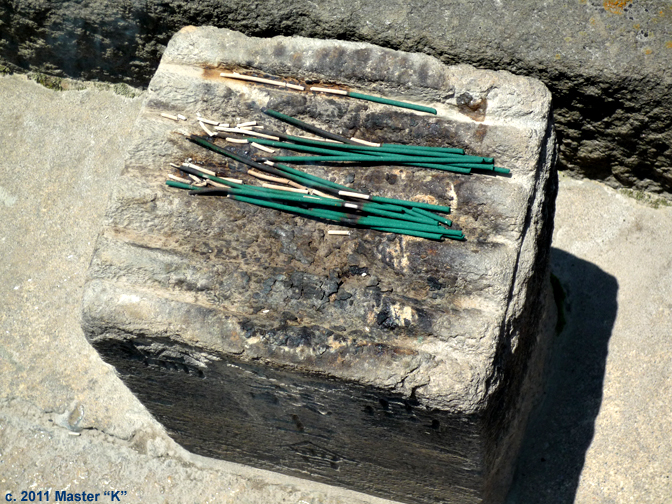The Beauty of Kinbaku
Or everything you always wanted to know about Japanese erotic bondage when you suddenly realized that you didn't speak Japanese
Meetings With Remarkable Men
A Trip to Japan - Meetings with Remarkable Men # 4 -
Urato Hiroshi, the great Nikkatsu rigger
by Master "K"
Greetings!
Other than the kinbaku, one of my favorite reasons for visiting Tokyo is the opportunity to study that country’s remarkable history firsthand. One of the best ways of doing this is to tour some of the fascinating examples of “living history,” the famous monuments and well preserved sites from past ages, which are scattered throughout this beautiful city. And if you keep your eyes open you might even notice some of the incredible and inventive, ritual and practical, uses for rope that the Japanese have perfected over the centuries.
For instance, there’s the Asakusa Kannon, Tokyo's largest Buddhist temple and home to the "Thunder Gate,” one of the main entrances to the Asakusa district and its famous shopping arcade. For many centuries Asakusa used to be Tokyo’s leading entertainment center and during the Edo Period (1603 to 1868), when the area was still located outside the city limits, Asakusa was the site of many kabuki theaters and a large red light district.
At the end of the arcade is the main gate, Hōzōmon, notable for a giant (6 ft high) straw sandal hung up on one side of the gate as a charm against misfortune and made of straw rope or aranawa, a material that’s also used occasionally for kinbaku.
Then there are the magnificent gardens of the Imperial Palace where the observant rope lover will note with astonishment that every flower bed and walkway is bordered by bamboo fencing where each protective pole is intricately tied in place! No plastic or metal fasteners here!
A final case in point is the Sengaku-ji temple, the last resting place of the renowned 47 Ronin; participants in one of the most famous incidents in Japanese history. It’s a samurai story that’s well known to every Japanese schoolchild and one that’s been turned into numerous artworks, television programs and film productions. This tale of the loyal retainers of a disgraced lord who were left leaderless samurai (ronin) after he was forced to commit ritual suicide (seppuku) for assaulting a court official and who then executed a secret and incredibly daring two year plan of revenge against their enemy and by so doing came to epitomize the samurai’s code of honor (bushido) is the stuff of legend and fiction … and yet it’s all true and the brave ronin’s final resting place can still be visited today on the outskirts of Japan’s busy capital.
Sengaku-ji temple is a dramatic and moody place set on a small hill overlooking Tokyo. When I visited there recently elegantly shaped Cumulus clouds scudded low
Such places, incidents and atmospheres and the Japanese films depicting them were much on my mind as I made my plans to meet Urato Hiroshi, the great movie rigger from Nikkatsu film studio’s Golden age. Here was a man familiar with what it took to make a situation dramatic … or erotic … and not just with his rope but with all the elements that go into making a filmed scene successful: costumes, props, acting, etc. As I left the temple grounds I was sure a man of his taste would savor the poetically charged atmosphere of this place.
Of the three legendary bakushi that I had made advance arrangements to meet during my trip (Nureki sensei, Yukimura sensei, and Urato sensei), Urato sensei is probably the least well known to my readers in the West. This is a pity since his accomplishments in kinbaku art are every bit as significant as those of his two more famous colleagues. Perhaps his are even more significant given the much wider audience he enjoyed for his tying efforts. After all, literally millions of fans saw his kinbaku in the many Nikkatsu SM oriented films released during the 1970s and 80s.
I first profiled Urato sensei in the "10 Famous Bakushi" series of articles I did for this site last year and the entire history of Nikkatsu Studios is covered in my book "The Beauty of Kinbaku," so I won't repeat all that information again here. However, for those that don't yet own the book and didn't see the series, here is the briefest summary.
Nikkatsu Studios, created in 1912, was one of Japan's oldest and most famous movie studies when, in the early 1970's, they found themselves on the verge of bankruptcy. In desperation they came up with the novel idea of throwing their dwindling resources into pinku eiga (erotic/sex films) which until 1971 had only been the province of second and third rate companies. To get an idea as to how momentous a decision this was, imagine the reaction in the United States if MGM had dropped the musicals and gone into erotica!
Unlike later cheaply produced adult video fare, these films were, in general, handsomely produced and intended for a wide audience. The best of the films boasted interesting stories, fine photography, star performers ... and some amazing kinbaku. Since many of the scenarios were set in the past, the rope work often authentically recreated the grim realities of the shogun's punishments, including remarkable suspensions. Other more modern tales featured equally interesting shibari used for more erotic purposes. For the interested viewer the question soon arose as to who was doing all this tying? Was it a crew of stunt men or special effects experts? After all, real stars were being bound and suspended!
To my complete delight Urato sensei seemed interested not only in meeting but also in accompanying me to the bookshops of Kanda (the famous used bookstore section of Tokyo) to help search out rare kinbaku historical texts and in acting as an intermediary with the prospective Japanese publisher of "The Beauty of Kinbaku" and, most exciting of all, in offering to do a demonstration of his unique style of tying. To say I was astounded by his kindness and generosity would be an understatement.
Given the above, it's understandable that I was a little nervous as my student Zetsu and I awaited Urato sensei's arrival at my hotel on a warm June afternoon. What would he be like, this giant of Japanese SM film? The minutes ticked down, the doorbell rang and as I opened the door in greeting to my guest I was astonished to see a nattily dressed, brightly smiling octogenarian of no more than 5 feet tall. Urato Hiroshi sensei on first sight resembled nothing so much as the Yoda of kinbaku!
Please note: no part of these articles may be reproduced by any means without the express written consent of the author or the publisher, King Cat Ink.
on the horizon and there was a stillness to the air that created a sense of mystery and timelessness. It can be quite spooky to stand alone among the tombstones with a gentle, ghostly breeze brushing past one's face and Tokyo quiet and distant on the horizon. For a long time a watchful black raven was my only companion until the mood was finally broken by the arrival of a Japanese family escorting a foreign friend for a visit to this famous and sacred place. They spent a few yen to buy some incense sticks from the temple caretaker and then reverently laid a few at the base of each of the 47 samurai’s tombstones.
As shocking as this seems, the move proved relatively successful and by 1974 the company had embarked on a new line of pinku eiga, this time incorporating SM themes. On June 22, 1974 the first film version of Dan Oniroku’s famous SM novel Hana to Hebi (“Flower and Snake”) was released and was quickly followed by Ikeniie Fujin (“Wife to be Sacrificed”). Both films were directed by Konuma Massaru and starred the remarkable actress Tani Naomi.
Whether this was sheer commercial desperation or a shrewd understanding of the zeitgeist of the moment can’t be known but the results were spectacular. “Flower and Snake” was very successful but “Wife to be Sacrificed” turned out to be a blockbuster, becoming not only Nikkatsu’s biggest hit of the year but also one of the studio’s five top grossing films of all time! Further SM oriented films quickly followed which have influenced generations of SM aficionados.
Much research in Los Angeles and Tokyo finally produced an answer. The kinbaku devised for over 40 of the most famous Nikkatsu films was the product of one man -- the mysterious and reclusive Urato Hiroshi.
It was just at the time that I was researching who had done the kinbaku for the Nikkatsu studios films that, through a series of remarkable coincidences, I made contact with a Japanese publisher interested in my book who casually mentioned that Urato Hiroshi was still living and able to be contacted! Thanks to luck and persistence we managed to track him down for an initial 6 hours of interviews in order to present his remarkable story on this site for the very first time. This in turn led to my plans to actually visit with Urato sensei during my Tokyo trip.
Please join me next time as my adventures with the remarkable Urato Hiroshi continue, I discover some of the secrets of his unique kinbaku tying techniques and learn more about his astonishing movie career during the Golden Age of Japanese SM!
